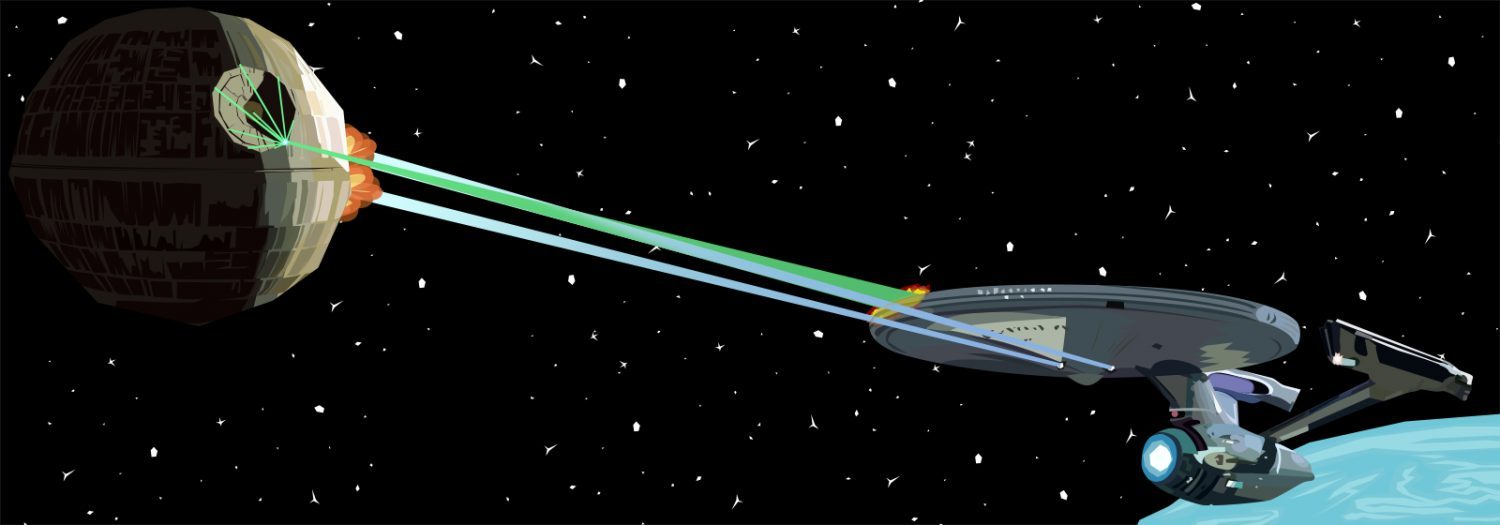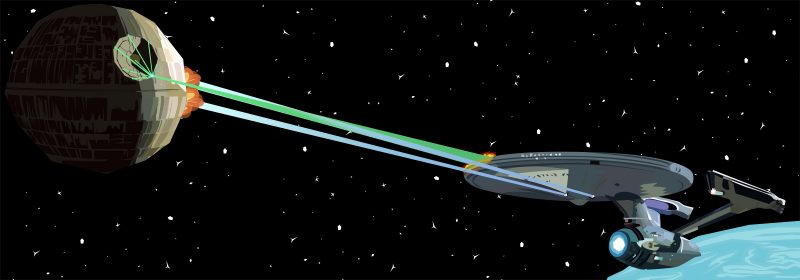Showdown of the Star Series: Wars vs. Trek


Isaac Asimov once defined the difference between the interconnected genres of science fiction and fantasy, calling the former possible and the latter not. This is the first clue toward the significant differences between the two major Star franchises, and it’s one that generally disqualifies the question of which one is objectively superior.
There’s no denying that Star Wars is the more popular brand. In the last year we’ve seen releases from both series and, while Star Trek Beyond raked in $343 million worldwide, it was a paltry drop in the bucket compared to Star Wars: The Force Awakens’ record shattering $2.06 billion total last December. On Dec. 16, the next instalment of the Star Wars series, Rogue One, will be released. With a projected opening weekend domestic gross of $130 million. It is also expected to tower over Beyond’s success.
Where Trek wins out is in sheer volume of content, something that could be argued for lower av-erage grosses as dilution of the brand. The major components of the Star Wars series include seven movies, compared to Trek’s thirteen. And Star Wars may have two separate series with a connected movie, but these are typically considered auxiliary fragments of the brand; nothing compared to the five major Trek series: totaling 703 episodes.
But these comparisons could literally be made between any two major media franchises. So why Trek vs. Wars, besides the obvious superficial association of the word ‘Star’?
There isn’t much. While one details the exploration of an advanced human society acting as diplomat to other worlds and creatures and ideas, the other is a simple tale of knights learning magic in order to advance their sword fighting against the oppressive governing state.
In order to especially disqualify the conversation, a controversial insistence must be made here to challenge preconceptions about space-travel and aliens: Star Trek is science fiction, while Star Wars is fantasy. Trek is speculative: a version of the human race that could come to fruition. Wars is indulgent: a tale of good against evil set in the impossible backdrop of “a long time ago, in a galaxy far, far away.” Trek varies its universe to suit the needs of a story; Wars varies its stories to fit within its intricately built worlds.
Beyond that, both function as entirely different products: while Star Wars has a more superficial duty: selling a wide breadth of merchandise, it also initially functioned as a revolutionary style of filmmaking. Using models and lights and sounds in an obtuse, creative fashion to create more distinct impressions of deep space, George Lucas solidified his career as a visionary filmmaker inspired by classic science fiction and fantasy stories.
This is why Star Trek, by comparison, doesn’t always look great. Deep space battles, even in more recent iterations of the series, have been represented by the cast obviously throwing themselves around a static set while the camera shook. They were cheesy — especially set against the breathtaking X-Wing dogfights from their perceived rival.
But Trek has always been about ideas and progress more than spectacle. While the original Star Wars apparently took place in a universe with only one non-white human, Nichelle Nichols had already participated in the first ever interracial television kiss.
While Wars was dressing Leah up in overly sexualized garb for the Jabba the Hutts of the world to ogle, Trek’s Tasha Yar was standing up to gendered preconceptions of alien cultures as the Enterprise’s head of security. And it took Star Wars until 2015 to cast a female lead, 20 years after Kate Mulgrew lead the cast of Star Trek: Voyager.
No one’s ever going to say that Star Wars and Star Trek embody even similar places in the space opera canon, so why must we insist on constantly comparing and contrasting the two?
Both franchises are wonderful pieces of fiction that draw huge media attention and create extensive fan communities. The deep reaches of outer space are wide enough for both.


